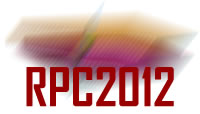Speaker
Mr
Pierre-Alain Loizeau
(Physikalisches Institut der Universität Heidelberg)
Description
The Compressed Baryonic Matter (CBM) experiment will be built at the new Facility for Antiproton and Ions Research (FAIR) in Darmstadt, Germany. This fixed target experiment will investigate Heavy Ion collision up to 35 AGeV for Au beams and 89 GeV for protons beams, with high interactions rates: up to 10MHz in Au+Au collision at 25 AGeV. To avoid the limitations of triggered systems at such rates, most CBM detectors will operate a free-streaming readout.
Charged hadrons identification, especially a Kaons-Pions separation up to 3.5 GeV/c, is provided in CBM by a Time of Flight (ToF) wall placed 10m after the target. This requires a time resolution for the full ToF system in the order of 80ps combined with a high efficiency. To achieve these performances, the wall is made of MRPC detectors with resistive materials and channel layout both adapted to the particle rates found in the 2.5° to 25° polar angle range. This design induces hit rates up to 200 kHz/channel in some of the detectors and a total channel count between 70k and 120k.
Because of those characteristics, the electronics needs a time resolution of 30 to 40ps, Time over Threshold capability and free-streaming readout. This free-streaming mode also requires a special care in the synchronization of the system and in the data analysis.
A first prototype of the complete high resolution, free-streaming chain was built in Heidelberg, from differential detector to dedicated softwares, and later tested at COSY in Juelich. It will be described in this contribution and its first in-beam performances will be presented.
Authors
Prof.
Norbert Herrmann
(Physikalisches Institut der Universität Heidelberg)
Mr
Pierre-Alain Loizeau
(Physikalisches Institut der Universität Heidelberg)

